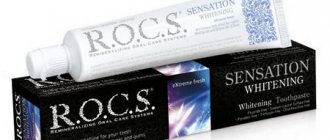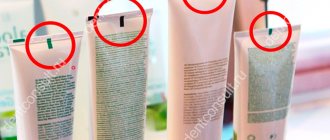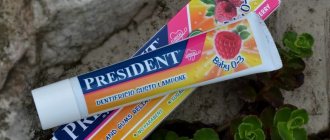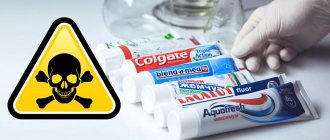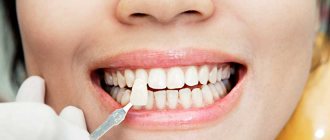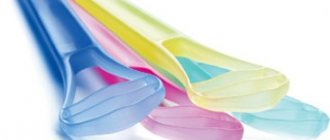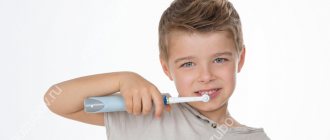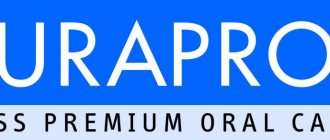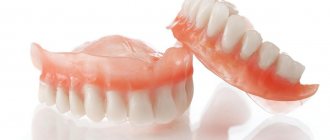How do abrasive toothpastes affect teeth?
The effect of abrasive pastes is similar to the effect of a scrub - small particles (abrasives) clean and polish the tooth. This will not replace professional whitening, but it will lighten the enamel by several tones. Moreover, it will do it quickly enough (the effect is visible almost immediately). It is quite safe to use such pastes, and their prices are quite affordable.
Any toothpaste contains abrasives - hard microparticles. In abrasive pastes, these particles are larger and therefore have a better cleaning effect.
Silicon compounds, titanium, aluminum oxide, polyethylene, calcium carbonate (chalk), clay, soda, and charcoal are used as abrasives. Some pastes contain multiple abrasives.
Index of abrasive toothpastes
Abrasiveness is determined by the RDA index, which reflects the degree of impact and particle size. The higher the indicator, the better the cleaning properties. However, the abrasive effect of the abrasive on the enamel is also higher.
- RDA up to 50 – non-abrasive paste for teeth with weak and sensitive enamel and dentures.
- RDA from 50 to 80 – low-abrasive paste for children.
- RDA 80-100 – medium abrasive paste. Intended for adults, for whitening by 1-2 tones. Suitable for continuous and occasional use.
- RDA greater than 100 – highly abrasive, used once or twice a week after consultation with a dentist.
Toothpaste with an RDA of up to 80 can be used as long as your gums and teeth are healthy. They should not be used by children or adults with bleeding gums, gingivitis, periodontitis, caries, or weak and damaged tooth enamel.
Toothpastes. Abrasiveness
The modern market boasts a variety of toothpastes. Quite often on the shelves of various stores, supermarkets and, of course, pharmacies we come across a huge assortment of different toothpastes that are not for a professional; most likely they differ only in the color of the packaging and the price. And, of course, not all of us pay attention to the chemical composition of toothpaste, much less its abrasiveness
. Does everyone know what is meant by this term?
Let's try to answer some basic questions:
What is toothpaste abrasive?
Abrasives are small particles that clean the enamel and dentin of the tooth root from plaque, colonies of bacteria from the surface of the teeth, food debris and stones. The abrasive-polishing component makes up from 20% to 40% of the total contents of the toothpaste. However, it is generally accepted that low-quality abrasive components, due to uncontrolled abrasiveness, injure tooth enamel and contribute to tooth abrasion. The coarser the abrasive used in toothpaste, the more traumatic it is for the tissues of the oral cavity and, especially for the teeth. Therefore, both dentists and their patients need to have information about the basic properties of the abrasive-polishing component included in the toothpaste.
The ideal abrasive polishing component must meet three basic requirements:
1. Have high cleaning ability.
2. Have a controlled degree of abrasiveness, safe for tooth enamel.
3. Be indifferent to other components of the toothpaste.
What is abrasiveness?
Abrasiveness is an indicator that determines the ability of toothpaste to disrupt the structure of tooth enamel and dentin due to mechanical action (abrasion) and at the same time the degree of cleansing of plaque from the tooth surface. The degree of abrasiveness is determined not only by the quantity, but also by the quality of the abrasive. The abrasion process primarily affects the neck of the tooth, and most often occurs on premolars and canines. The larger the particle size, the more harsh the abrasive effect the toothpaste has. The smaller the particle size, the lower the abrasiveness of the paste. The RDA index (RadioactiveDentinAbrasion) indicates the abrasiveness of dentifrices. To determine the abrasiveness of toothpastes, the International Standard ISO 11609-95 is used. (Determination of abrasivity (Hefferen) using the laboratory method of the American Dental Association (ADA). The abrasiveness of cleaning products is determined by comparison with a standard . The abrasion standard of the American Dental Association (ADA), which is taken from a special batch of calcium pyrophosphate, the holder of which is the Monsanto Company. The RDA index must be indicated on the packaging of any serious toothpaste. This means that the paste has “passed the exam” for safety for teeth, that the manufacturer cares about the health of the buyer.
The degree of abrasiveness of toothpaste, the possibility of its use and the type of toothbrush recommended for use can be represented as follows:
1. Extremely low abrasion: RDA = 0
—
20.
For sensitive teeth, an electric toothbrush. This toothpaste is intended for children. The level of abrasive content in children's and adolescent toothpastes should be minimal, since at this age the final formation of enamel has not yet occurred.
2. Low abrasion: RDA = 20–40.
It has low abrasiveness and certain components in its composition that reduce the sensitivity of the enamel. Non-mechanical toothbrush of low hardness; electric toothbrush (no more than twice a week).
Recommended for: patients with sensitive enamel, pregnant and lactating women, those who have undergone tartar removal procedures, patients with exposed tooth necks due to periodontitis.
3. Medium abrasive: RDA = 40–75
. For normal teeth, a non-mechanical brush with medium-hard bristles. This paste is suitable for all those people who have no special contraindications, such as, for example, loose and bleeding gums or sensitive teeth.
4. Highly abrasive: RDA = 80-100.
Non-mechanical toothbrush. As a preventive measure, for whitening healthy teeth with darkened enamel (coffee, strong tea, cigarettes). To remove “smoker’s plaque”, as well as for healthy teeth with strong enamel. But they are not recommended for daily use; these pastes can whiten teeth by 1-2 shades, but, as a rule, their constant use creates increased stress on tooth enamel.
5. Extremely highly abrasive:
RDA > 100
. Non-mechanical toothbrush. For cleaning teeth covered with crowns. With partial coverage - no more than 2-3 times a week, because, in addition to tooth tissue, high abrasiveness negatively affects the surface of the gums. Such pastes cannot be used for a long time and uncontrolled, as they can worsen the condition of the enamel and increase tooth sensitivity.
Does the abrasiveness of the paste harm your teeth?
An abrasive is necessary to remove plaque and polish the enamel, to reduce the adhesion (i.e. sticking) of bacteria to the enamel. Much depends on the quality of the abrasive. If you constantly use toothpaste with large abrasive particles, use a toothbrush with hard bristles and apply pressure on the tooth of more than 60-80g, you can quickly damage the enamel, trying to make your teeth white or increasing the intensity of brushing and reducing the time of brushing your teeth.
All these not unimportant subtleties will help you maintain a beautiful smile on your
face!
Be healthy!
Luchsheva Larisa Fayzylkhanovna – Candidate of Medical Sciences, Associate Professor of the Department of Dentistry
KGBOU DPO "Institute for Advanced Training of Healthcare Specialists"
Ministry of Health of the Khabarovsk Territory
Koreneva Inga Anatolyevna, dentist, KGBIZ “Dental Clinic No. 18” of the Ministry of Health of the Khabarovsk Territory
Marina Dmitrievna Tsvigunova, dentist, KGBIZ “Dental Clinic No. 18” of the Ministry of Health of the Khabarovsk Territory
How to choose an abrasive toothpaste
The determining factor is the problem that the paste is intended to solve. Such pastes perfectly clean and remove plaque, but do not radically whiten teeth. Therefore, if your teeth are already clean, there is no need for abrasive paste.
Abrasive toothpastes - description and characteristics
- "LakalutWhite" Germany. Abrasiveness index 120. Contains spherical abrasives that effectively remove pigment plaque and deposits on teeth. Fluoride compounds prevent the destruction of enamel. Not suitable for daily use. It is recommended to use 3-4 times a week.
- "President White plus". Italy. RDA index 200. Has high cleaning power, fights tartar, while at the same time has a remineralizing effect on enamel and protects gums. The abrasive components are represented by calcium glycerophosphate and a substance obtained from sea shells. The paste also contains Icelandic moss extract. It is recommended to use no more than once a week.
- "President White" Italy. RDA index 100. This paste uses calcium silicide as an abrasive. Fluoride protects teeth. Icelandic moss and mint provide care. A small drawback is the combination of calcium and fluoride, as well as the price.
- "President Smokers". Italy. RDA index 120. Recommended for smokers. Bamboo charcoal is used as an abrasive. Contains lime extract for fresh breath. Contains fluoride.
- "RembrandtStainDefying". USA. A moderately abrasive but highly effective toothpaste for those who smoke and drink a lot of coffee or tea. Aluminosil is used here as an abrasive, which copes well with pigment deposits. Citroxaine has a whitening effect, fluoride protects the enamel. Whitens teeth well. The paste can be used daily. Everything about this paste is good, except the cost - over 1.5 thousand rubles.
- "Splat - whitening plus." Russia. A good product from a domestic manufacturer. Contains two abrasives, fluorine and calcium. The abrasiveness index is unknown.
- "Silcaarcticwhite". Germany. RDA index 85. Low abrasive paste, suitable for frequent use. Contains three abrasives, pyrophosphates and fluorine. Quality product. Can be recommended for smokers and those who consume a large amount of colorful foods.
- "RocsproFreshMint". Russia. Contains one abrasive substance. Does not harm enamel. Good composition, gentle whitening.
- “Blendamed 3D White Luxe Glamor” Germany. RDA index 100. Silicon is used as an abrasive. The paste contains a lot of pyrophosphates. This is a drawback. Contains fluoride. Available in six modifications.
- "New Pearl - Gentle whitening." Abrasiveness index 139. Contains 2 abrasive substances - titanium and silicon compounds, calcium and bromelain, which removes plaque. No fluoride.
- "New pearl whitening." Russia. A budget product with good results. Disadvantage: it contains a lot of pyrophosphates.
- "Faberlic Expert Pharma White Plus". Russia. Provides lightening up to 2 tones, suitable for heavy smokers due to its pleasant mint aroma.
- AmwayGlister. USA. Abrasiveness index 110. Contains titanium dioxide and silicon compounds as abrasives. The paste has a mint taste, is very refreshing, and very economical.
- "AquafreshWhitening". RDA 113. Contains two abrasives and fluorine. Available in a tube with a dispenser.
- "Crest Extra Whitening". USA. RDA 130. Popular toothpaste in the USA for the whole family. Thanks to its balanced composition, it is suitable even for children. Economical. Gently whitens and removes plaque. Among other abrasive pastes from this manufacturer, you can pay attention to “CrestSensitivityProtection”, “CrestMulticareWhitening”, and the “Crest 3D White” series of pastes. Abrasive pastes from the Colgate line. Rich assortment. Silicon dioxide, calcium carbonate, and aluminum oxide are used as abrasives. Contains fluoride and parabens. "Colgate Tartar Control" - index 165, "Colgate 2-in-1Tartar Control/Whitening" - index 82. "ColgateUnderIcyBlast". — index 194.
- "Morning radonta." Russia. The manufacturer claims it as a paste that removes tartar. The abrasive is calcium carbonate. The composition includes plant extracts of Tibetan herbs.
- "Detarthrin." Russia. To remove tartar. The main component is silica. Available in 45 gram cans.
- "Diamond glow Swiss Smile". Switzerland. It has a low level of abrasiveness, but cleans and polishes teeth well due to the content of tiny diamond particles. In addition to diamond dust, it contains silicon and titanium compounds, turmeric and aloe. In general, the composition is very balanced. This product belongs to the luxury category, so a tube of paste costs more than 5 thousand rubles.
- "WhiteWash NANOB". Another luxury pasta. Contains silver particles, gently removes pigmentation and plaque, does not harm teeth.
- "Biorepair PRO Active Shield". Italy. Contains hydrated silica, zinc, xylitol, which clean teeth well, prevent the appearance of stone and protect enamel. Does not contain fluoride.
- "BlanXExtraWhite." Italy. Abrasiveness index 140 RDA. Whitens teeth well, suitable for smokers. Contains titanium dioxide, arctic moss extract and pyrophosphates. Contains fluoride.
- "Twin Lotus Premium Red". Thailand. Cuttlefish bone is used as an abrasive to remove pigment spots. Miswak inhibits the growth of pathogenic bacteria, including candida. Peppermint and eucalyptus oil relieve inflammation. No fluoride.
- "Twin Lotus Active Charcoal Charcoal" Thailand. Bamboo charcoal is used as an abrasive. The paste also contains clove oil and guava extract, which protect and heal gums. Suitable for daily use.
- Beverly Hills Formula Perfect White. Ireland. Abrasiveness index 93. Contains silicon dioxide, as well as substances that dissolve plaque. Paste with fluoride. "Every Hills Formula Perfect White Black." Ireland. Abrasiveness index 93. Activated carbon in its composition removes pigmentation and foreign odors. Fluorine is used as a remineralizer.
- "Marvis Whitening Mint." Italy. RDA index 190. The paste has a unique thick cream consistency due to the addition of cellulose resin. Refreshes the oral cavity due to its pronounced mint taste.
- BreathRx. USA. Abrasiveness index 120 RDA. Two pyrophosphate compounds break down plaque and remove pigmentation. Contains fluoride. Excellent breath freshener, as it contains eucalyptus and thyme, as well as zinc.
- "White&White". Japan. Calcium carbonate and silicon compounds are used as abrasives. Paste with fluoride. Index unknown. Use as directed.
Abrasive Toothpaste: What is RDA?
Do you know what the three letters RDA on a toothpaste package mean? The number indicated after the abbreviation determines whether the product will effectively cope with plaque and pigmentation, as well as how safe its use will be. RDA is an abrasiveness index that every more or less serious manufacturing company indicates on its product. Let's find out how abrasive toothpaste works, what RDA value is considered optimal and what abrasiveness index are popular teeth cleaning products.
2 style=”text-align: center;”>What is abrasive paste?
Abrasives are grinding micro particles.
Those who dream of a snow-white smile know that to achieve it you need to choose pastes with a high level of abrasiveness. The principle of operation of abrasive pastes is to mechanically remove bacterial plaque and pigmentation from the tooth surface. But such cleaning of teeth inevitably leads to abrasion of the enamel. In essence, this can be compared to cleaning a frying pan with a metal scraper: the dirt is removed, but the surface is also damaged.
Abrasives are microparticles of increased strength added to teeth cleaning products. Modern toothpastes most often use silicon dioxide, aluminum oxide, and dicalcium phosphate dihydrate. In addition, baking soda, chalk, and sea salt can be abrasives. These natural ingredients are commonly used in the production of organic dental care products. Abrasives in the composition can occupy up to 40% of the volume.
3 style=”text-align: center;”>Is abrasive paste safe?
The size and shape of abrasive particles can be different, this is what the RDA index indicates. The higher it is, the larger the grinding particles will be; the lower, the smaller. Accordingly, the abrasiveness number also indicates the safety of the enamel paste. The smaller it is, the more gentle the product will have an effect and vice versa - three-digit numbers indicate a high risk of damage to the enamel.
When choosing a paste taking into account the RDA level, you need to know:
- when the RDA is in the range of 30-50, the paste is considered non-abrasive, it is suitable for people with hypersensitive teeth, if there are problems with the gums, it is also used for cleaning dentures;
- if the RDA is in the range of 50-80, such a paste will be low-abrasive, it is recommended for dental care in childhood;
- products with RDA 80-100 are called moderately abrasive, they have a slight whitening effect and are suitable for constant use in adulthood;
- if the RDA is above 100, such a paste is called highly abrasive, it can only be used after consultation with a dentist and no more than once every 2 weeks.
Products with a high RDA are not suitable for everyday use.
Products with an RDA in the range of 70-80 units are considered optimal for regular hygiene procedures. However, this abrasiveness level is only suitable if the teeth and gums are healthy. Therefore, it is very important, when choosing abrasive toothpastes, to focus not on popular names, but on the recommendations of your dentist.
3 style=”text-align: center;”>Abrasiveness of famous toothpastes
Popular highly abrasive dentifrices designed to whiten your smile:
- President White Plus is a highly abrasive, fluoride-free toothpaste with an RDA of 200;
- ROCS Sensation Whitening – Russian-made paste, fluoride-free, RDA 139;
- Lacalut White – German toothpaste, contains fluoride, the effect of abrasive particles is enhanced by pyrophosphates, RDA 120;
- Amway Glister – silicon dioxide added as an abrasive, RDA 110;
- Aquafresh Whitening – contains sodium fluoride, comes in an unusual plastic bottle, RDA 113;
- Crest Extra Whitening – popular American paste, RDA 130;
- Colgate Whitening Advanced is one of the most budget-friendly RDAs
There are many ways to make your smile whiter. Find out what Amazing White teeth whitening is.
You can read what medications chronic tonsillitis is treated with and what symptoms it manifests here.
2 style=»text-align: center;»>Alternatives to abrasive pastes
In addition to abrasive components, enzymes or peroxides can be added to whitening toothpastes. Enzymes soften plaque, including stained plaque, and help remove it. The principle of enzyme operation is not in the mechanical removal of plaque, but in the breakdown of its protein base. This action of whitening toothpastes is considered gentle and does not harm the health of teeth. Most often, enzymes such as papain and bromelain are added to teeth cleaning products:
- papain is obtained from papaya fruits, this plant enzyme in its action resembles gastric juice, breaking down proteins into amino acids, due to which bacterial plaque is cleaned off with a brush without increased pressure;
- bromelain - found in pineapple juice, similar to papain, dissolves the protein base of dental plaque.
Their effect can be enhanced by polydon, a substance that suppresses the crystallization of soft plaque, that is, preventing the formation of tartar. Thanks to the polydon, bacterial plaque accumulates on the teeth less intensely during the day.
Experts recommend purchasing products with enzymes as an alternative to abrasive pastes.
Hydrogen or urea peroxide in the paste, upon contact with tooth enamel, enters into a chemical reaction, which will result in the release of active oxygen, which lightens the pigmented compounds in the enamel. Peroxides, in comparison with enzymes, are considered more dangerous; there are contraindications to the use of such agents, for example, chipped enamel, increased sensitivity of teeth. Moreover, their effectiveness is controversial. A small amount of peroxides is added to the formulations of products for regular use, which, according to experts, cannot give a pronounced effect.
Popular pastes that whiten enamel using active oxygen: ROCS Pro (contains carbamide peroxide), Splat Extreme White (in addition to carbamide peroxide, it contains the enzyme papain), Faberlic White Plus (paste with hydrogen peroxide).
3 style=”text-align: center;”>Is it worth using abrasive toothpastes?
Abrasive toothpaste is considered dangerous. In the bleaching industry, products with abrasives appeared much earlier than those with enzymes and peroxides. Today, dentists recommend avoiding abrasive compounds even for people with healthy teeth and strong enamel, and even more so for those suffering from hyperesthesia. With regular exposure of the tooth surface to grinding particles, the enamel becomes thinner, which leads to the development of caries and tooth destruction.
Find out why sorbitol is added to toothpastes.
You can read about Stopangin spray and its features here.
We review the types of President rinses here: .
Almost everyone who uses whitening products with abrasives in their composition notices the appearance of tooth pain when consuming food and drinks with contrasting (too cold or hot) temperatures, as well as sour and sweet foods. And for those who persistently continue to use highly abrasive products, despite the appearance of unpleasant sensations, the enamel, especially in the peri-gingival zone, becomes very thin, which leads to the development of cervical caries and wedge-shaped defect.
Having a snow-white smile is a natural desire, but it is important, when realizing it, not to jeopardize the health of your own teeth. When choosing oral care products, you should consult your dentist.
Conclusion
The choice of abrasive pastes is quite large; they should be carefully selected, focusing on the composition and condition of the oral cavity. For sensitive teeth, abrasive toothpastes with an RDA of up to 70 are suitable. If the teeth are healthy, then from 70 to 100. It is better to use them in courses, no more than two weeks, and not use electric toothbrushes during this time. Pastes above 100 RDA can damage teeth; it is better to use them no more than 1-2 times a week.
The best option would be to ask your dentist for advice. In some countries, the doctor prescribes toothpaste as well as medicine. And no one would think of buying pasta based on advertising or idle advice.
RDA or toothpaste abrasiveness index
When choosing a toothpaste, almost everyone pays attention to its properties - protection against caries, fight against inflammation, whitening. And rarely does anyone pay attention to what cleaning component it contains. It is very important that it not only effectively fights plaque, but also takes care of tooth enamel. When using toothpaste with very large cleaning particles, you need to take into account that they “scrape” the enamel, which causes its thinning over time. Toothpaste with small cleaning particles is not able to completely remove plaque. Therefore, when choosing a toothpaste, you must pay attention to the RDA value. What do the letters RDA mean? This is an abrasiveness index that indicates how effectively the paste will cope with pigmentation and plaque, as well as the safety of its use. Abrasiveness is the abrasive effect of a cleaning agent on teeth and the degree of plaque removal. Its degree is determined by both the quantity and size of the abrasive. The RDA (Radioactive Dentin Abrasion) index on toothpastes is indicated by every serious manufacturer. The abrasive in toothpaste is needed to remove plaque and polish the enamel. Toothpastes contain from 20% to 40% abrasive-polishing components. The abrasiveness index also indicates how safe the paste is for tooth enamel. The smaller it is, the more gentle the effect of the toothpaste, and vice versa - there is a high risk of damaging the enamel with toothpastes whose RDA is three-digit numbers. Below is the degree of abrasiveness of the toothpaste, the possibility of its use and the type of toothbrush recommended for use: -Extremely low abrasive: RDA = 0–20. For sensitive teeth, an electric (mechanical or ultrasonic) toothbrush. -Low abrasive: RDA = 20–40. For sensitive teeth, a non-mechanical toothbrush with low hardness; electric toothbrush (no more than twice a week). -Medium abrasive: RDA = 40–60. For normal teeth, a non-mechanical brush with medium-hard bristles. To remove “smoker’s plaque”, as well as for healthy teeth with strong enamel. -Highly abrasive: RDA = 60–80. Non-mechanical toothbrush. As a preventive measure, for whitening healthy teeth with darkened enamel (coffee, strong tea, cigarettes). -Extremely highly abrasive: RDA > 80. Non-mechanical toothbrush. For cleaning teeth covered with crowns. With partial coverage - no more than 2-3 times a week, because, in addition to the tooth bone, high abrasiveness negatively affects the gum surface. Otherwise, it’s a mild toothpaste with an RDA of 0–20.
17.07.2020
